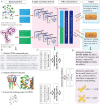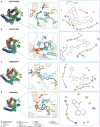Revolutionizing GPCR-ligand predictions: DeepGPCR with experimental validation for high-precision drug discovery
- PMID: 38864340
- PMCID: PMC11167311
- DOI: 10.1093/bib/bbae281
Revolutionizing GPCR-ligand predictions: DeepGPCR with experimental validation for high-precision drug discovery
Erratum in
-
Correction to: Revolutionizing GPCR-ligand predictions: DeepGPCR with experimental validation for high-precision drug discovery.Brief Bioinform. 2024 Jul 25;25(5):bbae427. doi: 10.1093/bib/bbae427. Brief Bioinform. 2024. PMID: 39147393 Free PMC article. No abstract available.
Abstract
G-protein coupled receptors (GPCRs), crucial in various diseases, are targeted of over 40% of approved drugs. However, the reliable acquisition of experimental GPCRs structures is hindered by their lipid-embedded conformations. Traditional protein-ligand interaction models falter in GPCR-drug interactions, caused by limited and low-quality structures. Generalized models, trained on soluble protein-ligand pairs, are also inadequate. To address these issues, we developed two models, DeepGPCR_BC for binary classification and DeepGPCR_RG for affinity prediction. These models use non-structural GPCR-ligand interaction data, leveraging graph convolutional networks and mol2vec techniques to represent binding pockets and ligands as graphs. This approach significantly speeds up predictions while preserving critical physical-chemical and spatial information. In independent tests, DeepGPCR_BC surpassed Autodock Vina and Schrödinger Dock with an area under the curve of 0.72, accuracy of 0.68 and true positive rate of 0.73, whereas DeepGPCR_RG demonstrated a Pearson correlation of 0.39 and root mean squared error of 1.34. We applied these models to screen drug candidates for GPR35 (Q9HC97), yielding promising results with three (F545-1970, K297-0698, S948-0241) out of eight candidates. Furthermore, we also successfully obtained six active inhibitors for GLP-1R. Our GPCR-specific models pave the way for efficient and accurate large-scale virtual screening, potentially revolutionizing drug discovery in the GPCR field.
Keywords: GLP-1R; GPCR; GPR35; drug screening; graph convolutional network.
© The Author(s) 2024. Published by Oxford University Press.
Figures







Similar articles
-
Virtual Screening of Human Class-A GPCRs Using Ligand Profiles Built on Multiple Ligand-Receptor Interactions.J Mol Biol. 2020 Aug 7;432(17):4872-4890. doi: 10.1016/j.jmb.2020.07.003. Epub 2020 Jul 9. J Mol Biol. 2020. PMID: 32652079 Free PMC article.
-
Molecular interaction fingerprint approaches for GPCR drug discovery.Curr Opin Pharmacol. 2016 Oct;30:59-68. doi: 10.1016/j.coph.2016.07.007. Epub 2016 Jul 29. Curr Opin Pharmacol. 2016. PMID: 27479316 Review.
-
Reliability of AlphaFold2 Models in Virtual Drug Screening: A Focus on Selected Class A GPCRs.Int J Mol Sci. 2024 Sep 21;25(18):10139. doi: 10.3390/ijms251810139. Int J Mol Sci. 2024. PMID: 39337622 Free PMC article.
-
Improving virtual screening of G protein-coupled receptors via ligand-directed modeling.PLoS Comput Biol. 2017 Nov 13;13(11):e1005819. doi: 10.1371/journal.pcbi.1005819. eCollection 2017 Nov. PLoS Comput Biol. 2017. PMID: 29131821 Free PMC article.
-
Structure-Based Virtual Screening for Ligands of G Protein-Coupled Receptors: What Can Molecular Docking Do for You?Pharmacol Rev. 2021 Oct;73(4):527-565. doi: 10.1124/pharmrev.120.000246. Pharmacol Rev. 2021. PMID: 34907092 Review.
Cited by
-
Identification and Validation of New DNA-PKcs Inhibitors through High-Throughput Virtual Screening and Experimental Verification.Int J Mol Sci. 2024 Jul 22;25(14):7982. doi: 10.3390/ijms25147982. Int J Mol Sci. 2024. PMID: 39063224 Free PMC article.
-
EnGCI: enhancing GPCR-compound interaction prediction via large molecular models and KAN network.BMC Biol. 2025 May 15;23(1):136. doi: 10.1186/s12915-025-02238-3. BMC Biol. 2025. PMID: 40375308 Free PMC article.
-
Protein Spatial Structure Meets Artificial Intelligence: Revolutionizing Drug Synergy-Antagonism in Precision Medicine.Adv Sci (Weinh). 2025 Sep;12(33):e07764. doi: 10.1002/advs.202507764. Epub 2025 Aug 7. Adv Sci (Weinh). 2025. PMID: 40775740 Free PMC article. Review.
-
Ligand-Induced Biased Activation of GPCRs: Recent Advances and New Directions from In Silico Approaches.Molecules. 2025 Feb 25;30(5):1047. doi: 10.3390/molecules30051047. Molecules. 2025. PMID: 40076272 Free PMC article. Review.
-
Bevacizumab in ovarian cancer therapy: current advances, clinical challenges, and emerging strategies.Front Bioeng Biotechnol. 2025 May 15;13:1589841. doi: 10.3389/fbioe.2025.1589841. eCollection 2025. Front Bioeng Biotechnol. 2025. PMID: 40474872 Free PMC article. Review.

